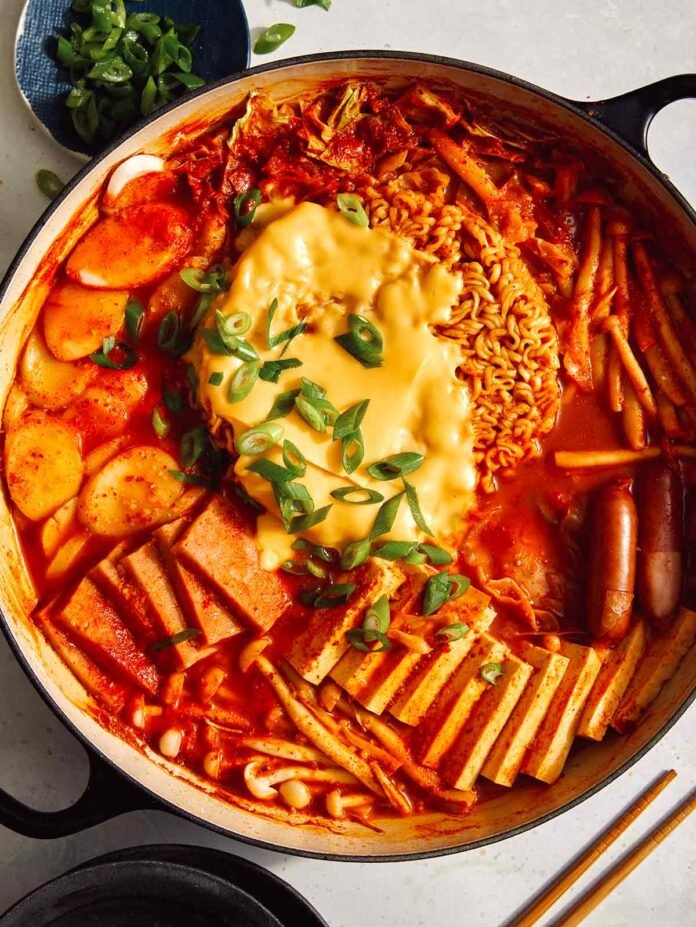A delicious Korean stew originally created post Korean war due to necessity and limited resources, Budae Jjigae is enjoyed today by many as an inexpensive kitchen sink type Korean stew with deep, rich flavors.

Budae Jjigae or Korean Army Stew is a delicious stew originally developed out of necessity after the Korean war. It’s a spicy kitchen sink type stew filled with processed meats, noodles, and a variety of other cheap ingredients, resulting in an incredibly flavorful family-style stew.
Budae jjigae is a bittersweet dish for many Koreans (including my relatives), but it also shows the resourcefulness of the people during a time of desperation and famine.
History of Budae Jjigae
Budae Jjigae also known as Korean army stew is a dish that was developed after the Korean war. It was during a time when food was scarce in Korea and people were dealing with famine.
It’s an inexpensive stew made up of American processed meats such as Spam and hot dogs left behind from American solider rations. Since resources were scarce during the time, any cheap ingredient was added into the stew to ultimately create a delicious, rich, flavorful stew that could feed an entire family.
Today you can find this stew served at many Korean restaurants that serve bar type foods like Korean Fried Chicken. It’s also incredibly easy to make at home with hundreds of variations based on personal preferences.

How to Make Budae Jjigae
Ingredients


Process
- Place all paste ingredients into a small bowl. Whisk together. Set aside.




- In a large, shallow pot arrange sausages, spam, tofu, cabbage, rice cakes, and mushrooms.
- Top with paste mixture.
- Pour water in pot and bring to a boil. Gently stir to evenly distribute the paste.
- Once mixture is brought to a boil, add noodles, and continue to cook until everything has cooked through, and noodles are soft.
- Top stew with American cheese and green onions and boil for another minute. Remove from heat and serve.


Tips and Tricks for Making the BEST Budae Jjigae
- The spicy paste sets the foundation for the overall stew, so you don’t want to skimp on the ingredients. It’s especially important to use gochujang for the authentic (slightly) sweet and spicy umami flavor it provides. (If you’re interested to learn more about gochujang and my preferred brands you can find more information in our Gochujang Noodles recipe post.)
- Keep things cheap and simple, like the dish was originally intended to be. It will truly give you the best flavor and experience!
- Eat it immediately after making it to ensure the noodles and rice cakes don’t bloat and become soggy.
Variations for Korean Army Stew
There are so many versions of Budae Jjigae out there and if you want to mix things up you can add:
- kimchi – which will add an additional spicy, fermented kick to the dish. If I add kimchi, I usually omit the green cabbage.
- Korean dumplings (mandu) – on occasion, when I want to ‘beef’ the dish up even more I add a few frozen mandu to the stew and it really makes a fantastic addition.
- canned baked beans – I’ve never added this into my Korean army stew, but know that it was one of the ingredients added back in the day and could see how the sweet, tangy and creamy flavors and textures would be a good fit!
- (cut up) hot dogs – which are more commonly used than the lil smokies we use in our recipe. Whichever you use, you won’t be disappointed.
- other quick cooking vegetables – I love bulking this stew up even more with simple vegetables – my favorites being julienne carrots and thinly sliced zucchini.
More Delicious Korean Recipes You Will Love
Hungry for more?
Subscribe to never miss a recipe.


Budae Jjigae (Korean Army Stew)
A delicious Korean stew originally created post Korean war due to necessity and limited resources, Budae Jjigae is enjoyed today by many as an inexpensive kitchen sink type Korean stew with deep, rich flavors.
Servings:
INGREDIENTS
INSTRUCTIONS
Place all paste ingredients into a small bowl.
Whisk together. Set aside.
In a large, shallow pot arrange sausages, spam, tofu, cabbage, rice cakes, and mushrooms.
Top with paste mixture.
Pour water in pot and bring to a boil. Gently stir to evenly distribute the paste.
Once mixture is brought to a boil, add noodles, and continue to cook until everything has cooked through, and noodles are soft.
Top stew with American cheese and green onions and boil for another minute. Remove from heat and serve.
NOTES
- The spicy paste sets the foundation for the overall stew, so you don’t want to skimp on the ingredients. It’s especially important to use gochujang for the authentic (slightly) sweet and spicy umami flavor it provides. (If you’re interested to learn more about gochujang and my preferred brands you can find more information in our Gochujang Noodles recipe post.)
- Keep things cheap and simple, like the dish was originally intended to be. It will truly give you the best flavor and experience!
- Eat it immediately after making it to ensure the noodles and rice cakes don’t bloat and become soggy.
Calories: 267kcal Carbohydrates: 39g Protein: 14g Fat: 16g Saturated Fat: 6g Polyunsaturated Fat: 2g Monounsaturated Fat: 7g Trans Fat: 0.1g Cholesterol: 33mg Sodium: 1159mg Potassium: 363mg Fiber: 2g Sugar: 3g Vitamin A: 726IU Vitamin C: 7mg Calcium: 147mg Iron: 2mg
CUISINE: korean, Korean-American
KEYWORD: korean army stew
COURSE: Breakfast, dinner, lunch






